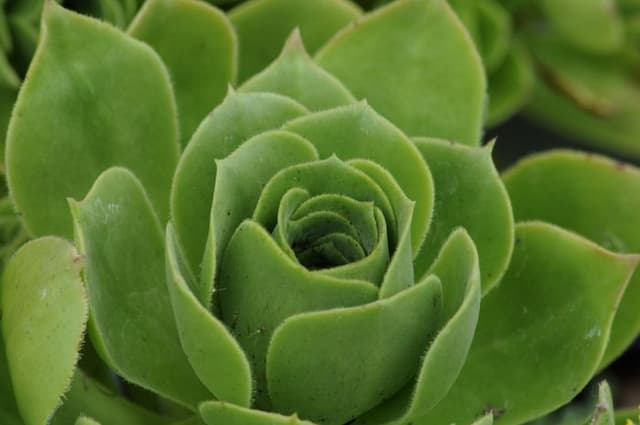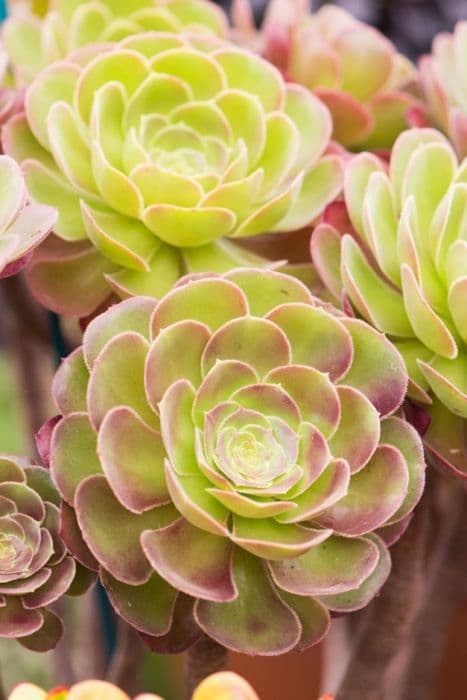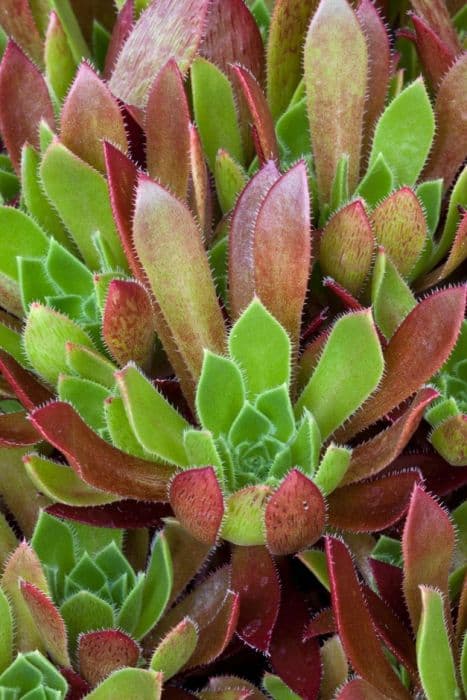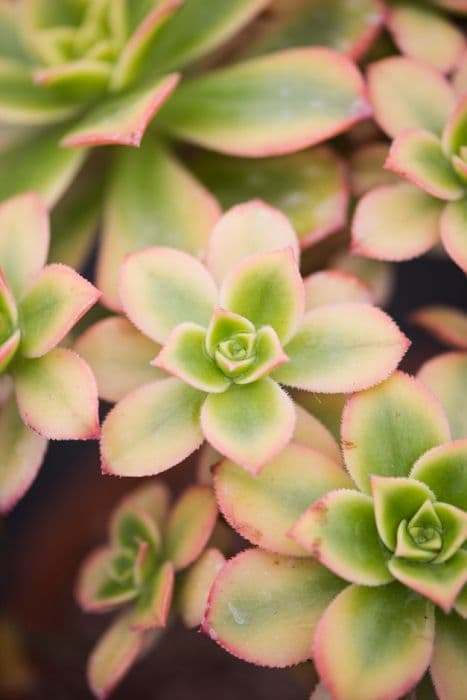Blue Echeveria Echeveria secunda f. secunda

ABOUT
The Echeveria secunda f. secunda, commonly known as the Echeveria, is a visually striking succulent that is admired for its compact, rosette-forming growth habit. The leaves of this plant possess a distinct appearance, typically broad and fleshy, which are arranged in a tight, symmetrical spiral. Oftentimes, the leaves exhibit a stunning glaucous, bluish-green hue that can be further accented by reddish-pink edges when exposed to just the right amount of sunlight, giving it a subtle, colorful outline. This plant's waxy, spoon-shaped leaves are thick, which enables it to store water and thrive in dry conditions. The texture of the leaves is often described as smooth and plump with a slight point at the tip, adding to the plant's overall geometric aesthetic. When flowering, the Echeveria sends up tall bloom stalks from the center of the rosette, each adorned with bell-shaped flowers that are often a pleasing orange or yellow color, providing a delightful contrast to the cool-toned foliage. The Echeveria's charm lies in its sculptural form - it possesses a curated look that is highly sought after for rock gardens, terrariums, and as a focal point in succulent collections. Its ability to form offsets, or "pups," around the base lends to its appeal, as these can be easily propagated to expand a collection or share with fellow plant enthusiasts. The serene and polished appearance of the Echeveria secunda makes it a popular choice among both novice and experienced gardeners seeking a low-maintenance yet aesthetically pleasing plant.
About this plant
 Names
NamesFamily
Crassulaceae
Synonyms
Blue Echeveria, Glauca, Hen and Chicks
Common names
Echeveria glauca Baker, Cotyledon secunda Booth ex Lindl., Echeveria glauca f. secunda (Booth ex Lindl.) A.Berger, Echeveria secunda var. glauca (Baker) Poelln.
 Characteristics
CharacteristicsLife cycle
Perennials
Foliage type
Evergreen
Color of leaves
Green
Flower color
Red
Height
0.5 feet (15 cm)
Spread
0.5 feet (15 cm)
Plant type
Succulent
Hardiness zones
9
Native area
Mexico
Benefits
 General Benefits
General Benefits- Low Maintenance: Echeveria secunda, commonly known as Hen and Chicks, requires minimal care, making it an ideal choice for beginners or those with busy lifestyles.
- Drought Tolerant: Adapted to dry conditions, it is ideal for water-wise gardening, reducing the need for frequent watering.
- Aesthetic Appeal: With its rosette shape and varying hues, Hen and Chicks offers visual interest and can enhance the beauty of any garden or indoor space.
- Suitable for Containers: It is perfect for container gardening, allowing for flexibility in placement and easy incorporation into small or urban spaces.
- Pest Resistant: Generally resistant to pests, lessening the need for chemical pest control treatments.
- Propagation Ease: Easy to propagate from leaves or offsets, enabling gardeners to expand their collection or share with others.
- Attracts Pollinators: During its blooming season, it may attract pollinators like bees, beneficial for the environment and local ecosystems.
- Year-Round Interest: With evergreen foliage, Hen and Chicks maintains its appearance throughout the seasons, offering continuous interest in the garden.
 Medical Properties
Medical PropertiesThis plant is not used for medical purposes.
 Air-purifying Qualities
Air-purifying QualitiesThis plant is not specifically known for air purifying qualities.
 Other Uses
Other Uses- Photography and Art: Echeveria secunda, commonly known as Glauca, is often used as a subject in photography and botanical illustrations due to its aesthetic symmetrical rosette shape.
- Wedding Decor: The Glauca can be used as a sustainable and attractive option for wedding bouquets, table arrangements, and boutonnieres.
- Education: Botanical gardens and educators may use Glauca to teach about succulent care, xeriscaping, and water-wise gardening practices.
- Culinary Presentation: The rosettes of Glauca can act as natural, decorative holders for small appetizers or garnishes in culinary arts.
- Themed Events: Glauca can be incorporated into event decor for sustainability-themed or gardening workshops to create an appropriate ambiance.
- Psychotherapy Offices: The soothing form of Glauca can be used in therapy settings to provide a serene visual element for clients.
- Mindfulness Practices: Gardeners and individuals may engage with the Glauca plant while practicing mindfulness or meditation, focusing on its texture and form as a point of concentration.
- Green Roofs: This plant is a suitable candidate for green roofing projects because of its drought tolerance and ability to thrive with minimal soil depth.
- Eco-friendly Packaging: Dried Glauca leaves can be used as a sustainable, biodegradable alternative to plastic cushioning in packaging delicate items.
- Jewelry Making: Dried or preserved rosettes of the Glauca can be used as organic elements in crafting handmade jewelry, such as pendants and earrings.
Interesting Facts
 Feng Shui
Feng ShuiThe Hen and Chicks plant is not used in Feng Shui practice.
 Zodiac Sign Compitability
Zodiac Sign CompitabilityThe Hen and Chicks plant is not used in astrology practice.
 Plant Symbolism
Plant Symbolism- Perseverance: Echeveria secunda, commonly known as Blue Echeveria, has the ability to thrive in arid conditions, symbolizing the resilience and determination to persist despite challenges.
- Adaptability: Its capability to store water in its leaves allows it to adapt to changing environments, representing flexibility and the ability to adjust to new circumstances.
- Beauty and Serenity: The Blue Echeveria's attractive rosette shape and calming blue-green hue are often associated with tranquility and aesthetic pleasure.
- Enduring Love: Because it's a succulent that requires minimal water and care to maintain, the Blue Echeveria is sometimes given as a gift to symbolize enduring and low-maintenance relationships.
- Prosperity: In some cultures, succulents symbolize wealth and prosperity due to their lush, full appearance and their ability to propagate easily.
 Water
WaterThe Hen and Chicks succulent should be watered thoroughly when the soil is completely dry, roughly every 7-10 days during the active growing season in spring and summer. In the wintertime, when it's dormant, reduce watering to once a month or when the soil is dry to the touch. When watering, give enough water to soak the soil to the point that water runs out of the drainage holes. This could be approximately 8-12 ounces for small pots or up to a gallon for larger pots, depending on the size of your container.
 Light
LightHen and Chicks prefers bright, indirect sunlight and can tolerate direct morning light but should be protected from harsh afternoon sun to prevent scorching. A south or east-facing window is often ideal for indoor plants, or a spot in the garden that receives some shade during the hottest part of the day.
 Temperature
TemperatureHen and Chicks thrives in a temperature range of 65-80 degrees Fahrenheit during the day and should not be exposed to temperatures below 30 degrees Fahrenheit as it can cause freeze damage. The ideal temperature range is between 65 and 75 degrees Fahrenheit for optimal growth.
 Pruning
PruningPruning Hen and Chicks is mostly done to remove dead or damaged leaves and to maintain its rosette shape. It’s best to prune in the spring or early summer at the beginning of the plant’s active growth period. Hen and Chicks generally require minimal pruning, and it should be carried out as needed rather than on a regular schedule.
 Cleaning
CleaningAs needed
 Soil
SoilEcheveria secunda, also known as glaucous echeveria, prefers a well-draining soil mix composed of half succulent mix and half perlite or sand. The ideal soil pH for glaucous echeveria is around 6.0 (slightly acidic).
 Repotting
RepottingGlaucous echeveria should be repotted every two years or when it outgrows its current pot to ensure healthy growth and prevent root-bound conditions.
 Humidity & Misting
Humidity & MistingGlaucous echeveria thrives in dry conditions and does not require high humidity levels; average indoor humidity is sufficient for its growth.
 Suitable locations
Suitable locationsIndoor
Place glaucous echeveria in bright, indirect sunlight indoors.
Outdoor
Grow glaucous echeveria in full to partial sun outdoors.
Hardiness zone
9-11 USDA
 Life cycle
Life cycleThe Echeveria secunda f. secunda, commonly known as Echeveria 'Blue Echeveria,' begins its life cycle as a seed, which once germinated, develops into a small rosette. As it matures, the rosette grows larger and the plant may produce offsets, or "pups," around its base, which can be separated and grown as new individuals. During the growing season, typically spring and summer, the Blue Echeveria produces lush, blue-green leaves. After reaching maturity, which can take several years, it will send up a flower stalk with bell-shaped flowers, usually in shades of pink or yellow, attracting pollinators. Once flowering is complete, the plant may enter a period of dormancy, particularly in cooler temperatures or during the winter months. The life span of an individual rosette can end after flowering (monocarpic behavior), but the species perpetuates itself through the pups.
 Propogation
PropogationPropogation time
Spring-Summer
Echeveria secunda f. secunda, commonly known as Echeveria 'Glauca', is best propagated in the spring or early summer when conditions are ideal for growth. The most popular method of propagating this succulent is through leaf cuttings. To propagate through leaf cuttings, a healthy, full leaf is gently twisted off from the stem, ensuring that it's a clean pull with no part of the leaf left on the stem. The leaf is then left to dry for a few days until the cut end callouses over. After the calloused period, the leaf is placed on top of a well-draining soil mix and lightly misted with water. In a few weeks, the leaf should begin to sprout roots and a new rosette. It’s important to provide bright, indirect light and to avoid overwatering, as standing water can cause the leaf cutting to rot.









